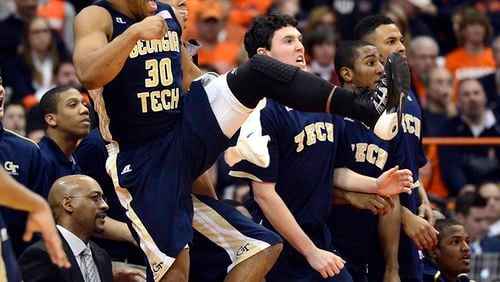Georgia Tech center Daniel Miller saw it coming. Last Thursday, he noted that the Yellow Jackets had been able to stay competitive with most of its ACC opponents, and that Syracuse had played a number of close games.
“I think we can be strong enough to at least hang with them,” he said. “I plan on winning.”
Underneath the Carrier Dome stands Tuesday night, as the Jackets celebrated their 67-62 win over No. 7 Syracuse, Miller was asked if he was surprised.
“No,” he said. “I told you I planned on it.”
For the record, Miller also said that “I think this is the time” to beat Clemson in advance of the Jackets’ 63-55 loss to the Tigers Feb. 22, so his premonitions aren't always accurate. But he proved prophetic Tuesday in an upset of the No. 7 RPI team by the No. 172 team. A look at how Tech pulled off the biggest win of coach Brian Gregory’s three-year tenure at Tech.
The right game plan
It could be argued that Tech was actually reasonably well-suited to attack Syracuse’s 2-3 zone because of its trio of big men, particularly Miller and forward Robert Carter. Tech’s plan was to get the ball into the high post, which would cause the zone to collapse and in so doing create options for the Jackets. Miller and Carter are two of Tech’s best passers and their size negated Syracuse’s length. The plan to deliver them – and also forwards Kammeon Holsey and Marcus Georges-Hunt – the ball near the free-throw line gave them license to initiate offense by either passing to the perimeter for jump shots or into the low post. On the perimeter, Tech moved the ball quickly in reversing it to get the ball into openings before the Orange could apply pressure on the ball.
It was clear from the start. In a 10-3 run midway through the first half, Holsey scored when Miller passed to him out of a double team, guard Chris Bolden hit a 3-pointer on a shot set up by a pass into the post, Holsey scored again in the post and then forward Quinton Stephens hit a 3-pointer when Carter found him with a cross-court pass out of a double-team trap on the sideline. It gave the Jackets a 21-14 lead and forced coach Jim Boeheim to call timeout as Stephens ran up the court pumping his fist.
Said Gregory of the team's execution, "Exactly how we wanted to do it."
Carter and Miller both had a team-high four assists. Half of them were to each other, including an alley-oop dunk by Miller with 9:03 to play.
“I thought our guys did a great job of executing the game plan in terms of taking care of the basketball, moving the basketball, getting the ball underneath their zone and making some plays for each other,” Gregory said.
Coaches wanted to avoid quick shots and called for players to get the ball into the post before they attempted a 3-point shot.
“What we were doing, we looked at other games, and we felt that, even if we got the ball in the last 15 seconds of the shot clock, we were going to be O.K.,” Gregory said. “So we shortened the game up with possessions. That kind of, to be honest, maybe lulled them to sleep a little bit.”
Miller and Carter were the horses Tuesday. In front of a number of NBA scouts, Miller was 7-for-10 for 15 points with six rebounds, six blocks, four rebounds, two steals and no turnovers. Carter had 12 points, nine rebounds, four assists, two blocks against four turnovers. For Miller, it was redemption for a poor performance in last week's loss to Notre Dame.
Said Miller, "It feels really good."
Better defending the break
Tech had had major problems stopping the ball in transition in the past three games, all losses, to Clemson, Notre Dame and Florida State. It was paramount Tuesday, with point guard Tyler Ennis leading an array of Syracuse players able to score easy baskets in the open court and get the Carrier Dome crowd into the game.
However, the Jackets were largely successful in retreating after misses and turnovers to force the Orange into running their half-court offense. Syracuse was credited with six fast-break points, although that statistic is rather subjectively judged.
“We did a good job defensively and we kept them out of transition, which is so important, because our half-court defense is pretty good,” Gregory said.
Held firm down the stretch
Tech’s tendency to give away leads and momentum is no secret. Loss of focus, lack of toughness and fatigue have been among the factors. For most of the second half, the Jackets refused to wilt, answering Syracuse baskets with baskets of their own.
Gregory breaks down games into 10 “rounds,” as in a boxing match, with each round going the four or so minutes between TV timeouts. Tech braced for Syracuse to get back into the game after being down eight at halftime, and the Orange did twice slice the lead to four points, but Tech was able to return the lead to eight by the first TV timeout of the second half at 15:32.
“When they cut the lead to start the second half and we responded, I thought at that 16-minute timeout, when we were even in that round and we told our guys that, I think you looked around and you saw a very confident group,” Gregory said.
Syracuse did make a desperate charge at the end of the game, reducing what had been a 12-point lead at the 5:06 mark to four with 1:51 to go and two with 36 seconds remaining. Miller, Georges-Hunt and Carter all missed the front end of one-and-ones in the final 4:03 and Tech only made one basket, a Miller dunk, in the final 5:06. But Golden was clutch at the end, going 6-for-6 from the line in the last 35 seconds.
“Those are things that are important in building the program, and our guys did a great job of that, sticking together, telling the guy who just made a mistake to get his head up, (that) we’re going to be fine,” Gregory said.
Ball control
Tech handled the ball about as well as could be hoped. Syracuse had forced an average of 11.4 turnovers per game in 16 ACC games prior to Tuesday, while the Jackets had averaged 11.9. Tech had nine Tuesday night. It limited Syracuse’s chances to score easy baskets in transition and build the momentum it needed to get back into the game.
Guards Golden, Bolden and Corey Heyward turned the ball over once in a combined 78 minutes of play while getting credited for eight assists. The Jackets have often been loose with the ball – they were dismal in the Feb. 22 loss to Clemson, when the Tigers scored 18 points off of Tech’s giveaways – but moved the ball quickly against the zone in the halfcourt. Against the full-court pressure, Tech showed patience in working the ball upcourt, many times using up most of the 10 seconds to get the ball over the center stripe.
Golden was particularly effective in that role, showing a little more burst than he has had since his groin injury as he pushed the ball up against the full-court press.
“Our guards did a really good job (against the press),” Gregory said. “Trae has obviously helped us out quite a bit.”
Ironically, Tech had less-than-ideal preparation for the game. There was no practice where the team could get to go against a scout team simulating the Syracuse zone. After the loss to Florida State Sunday night, the Jackets stayed overnight in Tallahassee, Fla., had a game-plan meeting Monday morning prior to flying up to Syracuse, N.Y., where they had a walk-through at the Carrier Dome that night. There was also a meeting and a shootaround Tuesday. It was the team’s only two-day turnaround of the ACC season.
“Maybe that’s the formula,” Gregory said. “You can’t really practice it in the 24 hours that we had, but the guys executed it really well and they didn’t panic.”
Interesting to note: In the past three games, as Golden has been paired with Heyward in the starting lineup, the Jackets have had six, eight and nine turnovers. They had had two single-digit turnover games in their previous 27.
Syracuse helped
It was not Syracuse’s finest moment. Offensively, only forward C.J. Fair and Ennis were producing, as the five other players who took the court combined for 16 points on 22 shots. Notably, guard Trevor Cooney was 1-for-8 from 3-point range despite a number of open looks at the basket. Cooney made half of his 86 3-point tries in non-conference play but is shooting 31.3 percent (40-for-128) in ACC play. The Orange were largely kept off the offensive glass. They shot an abysmal 7-for-16 from the free-throw line.
Most prominently, forward Jerami Grant was held out to rest a back injury that he suffered in the second Duke game. Grant is averaging 11.0 points per game and 7.3 rebounds in ACC play.
“People don’t want to hear it and coaches don’t want to use it as an excuse, but Syracuse is not the same team without Grant,” Gregory said. “They’re just not and they haven’t been since he’s been banged up.”
It's possible the Orange may be a little overvalued at No. 7. Syracuse had a number of close calls in racing out to 25-0, beating Duke in overtime Feb. 1, needing a buzzer-beating 3-pointer to beat Pittsburgh Feb. 12 and beating N.C. State Feb. 15 by one point with the help of two Wolfpack turnovers in the final 22 seconds. Syracuse has now lost four of its past five.
About the Author







